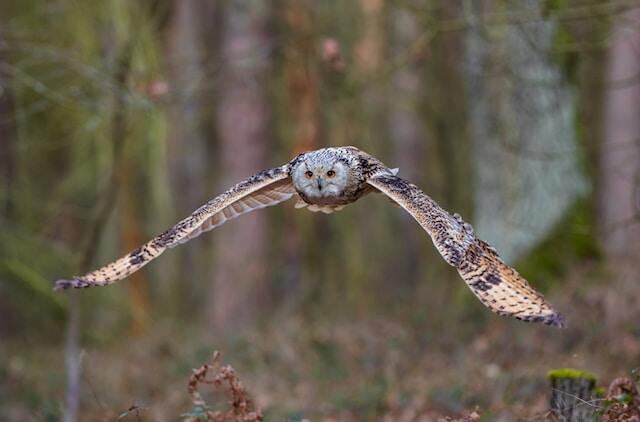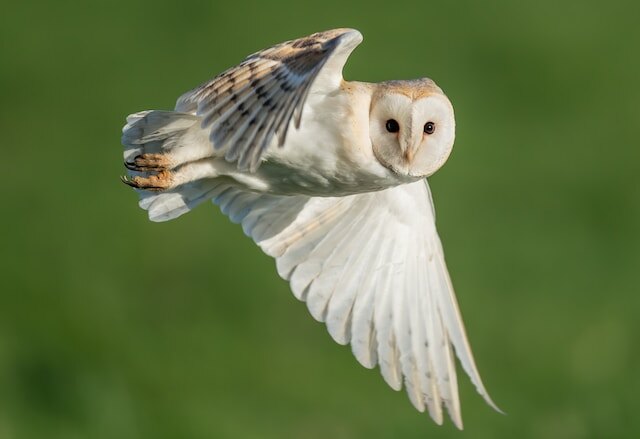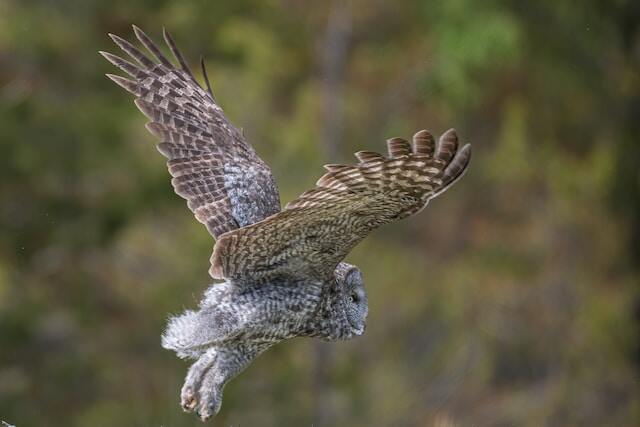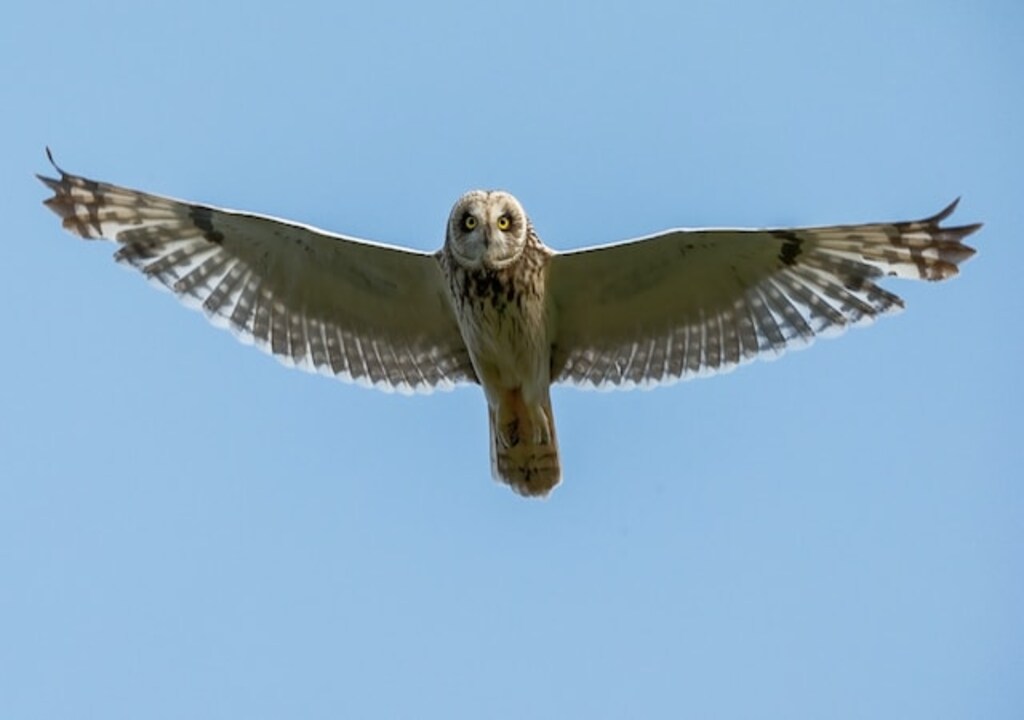Have you ever wondered how do owls fly silently? It turns out these nocturnal creatures have a few tricks up their feathers. The short answer to “How Do Owls Fly Silently?” is that they have special adaptations that allow them to muffle the sound of their wings in flight.
But there’s more to it than just a simple answer. In this article, we’ll explore the science behind owl flight and discover how these stealthy hunters are able to move through the night undetected. So let’s hoot and holler and get into it!
Table of Contents
Factors Contributing to Owls’ Unique Ability
There are several factors that contribute to this unique ability of owls. The first factor is in the structure of an owl’s wings.
Unlike other birds, owls have large wings with a unique shape that allows them to glide through the air with minimal resistance and noise. The second factor that allows for silent flight in owls is feather adaptations.
Owls’ feathers have a specialized structure that helps dampen sound and reduce turbulence as they fly. Their flight feathers have fringed edges which help break up sound waves as they pass over them, preventing noise from being created.
Additionally, many owl species also have soft surface feathers on their wings and bodies which further muffle any sound during flight. These adaptations allow owls to move through the night sky undetected by potential prey or predators.
Owls also use specific flying techniques which contribute to their silent flight abilities. One such technique is called “flap-gliding”.
Instead of continuously flapping their wings like most birds, owls flap intermittently before gliding through the air for long distances without creating any noise. Another technique used by some owl species is called “bounding”.
This involves flapping rapidly before gliding in a series of short bursts, which allows for quick movements while still maintaining silence in flight. It is important to note that not all owl species have the same level of noise reduction in flight.
Some larger species, like the Great Horned Owl, are still able to create some noise as they fly due to their size and weight. However, even these large owls are able to fly with significantly less noise than other birds of their size.
Owls are remarkable creatures that have adapted unique abilities in order to survive in their nocturnal habitats. Their silent flight is just one of many fascinating aspects of their behavior that continues to captivate scientists and bird enthusiasts alike.
| Factors | Description |
|---|---|
| Wing Structure | Owls have large wings with a unique shape that allows them to glide through the air with minimal resistance and noise. |
| Feather Adaptations | Owls’ feathers have a specialized structure that helps dampen sound and reduce turbulence as they fly. Their flight feathers have fringed edges which help break up sound waves as they pass over them, preventing noise from being created. Additionally, many owl species also have soft surface feathers on their wings and bodies which further muffle any sound during flight. |
| Flying Techniques | Owls use specific flying techniques like “flap-gliding” and “bounding” that allow them to move through the night sky undetected by potential prey or predators. Flap-gliding involves intermittently flapping their wings before gliding through the air for long distances without creating any noise. Bounding involves flapping rapidly before gliding in a series of short bursts, allowing for quick movements while still maintaining silence in flight. |
| Species Differences | Not all owl species have the same level of noise reduction in flight. Some larger species, like the Great Horned Owl, are still able to create some noise as they fly due to their size and weight. However, even these large owls are able to fly with significantly less noise than other birds of their size. |

Anatomy of an Owl’s Wings
The Importance of Shape and Structure
Owls have a unique wing shape and structure that allows them to fly silently. Their wings are large, broad, and rounded at the tips, with a sharp leading edge that cuts through the air. The feathers on their wings are also arranged differently than on other birds.
Instead of overlapping like shingles, they lie flat against each other, creating a smooth surface. This specialized shape and structure help owls to reduce turbulence and noise when flying through the air.
The broadness of their wings provides lift, while the rounded tips reduce drag. The sharp leading edge allows for efficient movement through the air without causing disturbance or noise.
| Feature | Description |
|---|---|
| Broadness at wingtips | Provides lift |
| Rounded tips | Reduces drag |
| Sharp leading edge | Allows for efficient movement through the air without causing disturbance or noise |
| Feather arrangement | Instead of overlapping like shingles, they lie flat against each other, creating a smooth surface. Helps to reduce turbulence and noise when flying through the air |
A Comparison to Other Bird Species’ Wings
When compared to other bird species’ wings, owls have several unique features that allow them to fly silently. For instance, songbirds have pointed wings that are designed for rapid flight in short bursts.
On the other hand, raptors such as eagles and hawks have wide wingspans but lack the special adaptations that allow owls to fly quietly.
The shape of an owl’s wing is also different from those of other birds because it is optimized for gliding rather than flapping flight.
Flapping flight is more energy-intensive and creates more turbulence in the surrounding air than gliding flight does.
Another key difference between owl wings and other bird species’ wings is the placement of their primary feathers relative to one another.
Unlike most birds where primary feathers overlap each other like shingles on a roof, an owl’s primary feathers lie flat against each other, creating a smooth surface that helps silence their otherwise noisy flight patterns.
Owls’ wing structures possess unique characteristics which include broadness at wingtips & special arrangement of feather which enables silent flying capability, while its sharp edges provide efficiency in the air.
These features are significantly different from other birds, and they help owls fly silently, making them fantastic predators.
| Bird Species | Wing Features |
|---|---|
| Songbirds | Pointed wings designed for rapid flight in short bursts |
| Raptors | Wide wingspans, but lack the special adaptations that allow owls to fly quietly |
| Owls | Wing shape optimized for gliding rather than flapping flight. Primary feathers lie flat against each other for silent flight |

Feather Adaptations
Fringed Edges and Soft Surfaces
Fringed edges and soft surfaces are some of the remarkable features that help owls fly silently, thanks to their specialized feathers.
Unlike the feathers on other birds, owl feathers have an unusual structure, primarily the primary, secondary, and tertiary feathers.
These feathers have fringed or serrated edges along the trailing edge, which break up the sound waves created by air rushing over the wing surface, thus muffling any noise that would otherwise be made during flight.
Additionally, owls’ feathers also have soft surfaces that help to absorb some of the energy generated by airflow over them, thus preventing turbulence.
Without these adaptations, owls would create a lot of noise when they fly, alerting their prey and making hunting almost impossible.
| Feature | Description |
|---|---|
| Primary feathers | Longest and stiffest feathers on the wings |
| Fringed edges | Serrated edges along the leading edge |
| Soft surfaces | Feathers have a soft texture to prevent turbulence |
| Function | Break up sound waves and absorb energy generated by airflow |
| Importance | Essential for owls’ ability to fly silently |
Differences from Other Birds
While all bird species have specialized feathers for different purposes, owl feathers differ significantly from those of other birds.
For example, most bird species have smooth-edged primary wing feathers that are adapted for maximum lift and stability during flight, rather than quietness.
Some bird species do have serrated or even falcate (curved) primaries like those seen in owl wings; however, these adaptations serve different purposes than silent flight.
For example, peregrine falcons have curved wing tips that help them fly at high speeds without losing control. The unique feather adaptations found in owl wings are essential for their ability to fly silently.
Their fringed edges break up sound waves, while their soft surfaces absorb energy generated by airflow over them.
Compared to other birds’ wings, these feather structures differ significantly in their structure and function. It is truly fascinating to see how nature has equipped these nocturnal hunters with such incredible abilities!
| Feature | Description |
|---|---|
| Primary wing feathers | Smooth-edged in most bird species |
| Adaptation | Adapted for maximum lift and stability during flight |
| Serrated or falcate primaries | Found in some bird species but serve different purposes |
| Peregrine falcon | Curved wing tips help them fly at high speeds without losing control |
| Importance | Owl feathers differ significantly from other birds’ feathers and are essential for their silent flight ability. |

Flight Techniques
Slow Flapping and Gliding
When it comes to flying, owls have a unique technique that allows them to move through the air without making a sound. Unlike most birds, owls don’t rely on rapid wing beats. Instead, they use slow flapping and gliding to stay aloft.
This method of flight is especially effective when hunting, as it allows them to sneak up on their prey without being detected. When an owl takes off from its perch, it starts with a few powerful wing beats to gain altitude.
Once it’s high enough, the owl will spread its wings out and start to glide forward. The wings are held at an angle that creates lift and reduces drag, which helps the bird move effortlessly through the air.
| Flight Technique | Description |
|---|---|
| Slow flapping | Owls use slow flapping of their wings to stay aloft. |
| Gliding | Once the owl reaches a certain height, it spreads its wings out and glides forward. |
Comparison to Other Bird Species’ Flight Techniques
Compared to other bird species, owls’ flight techniques are quite different. Most birds use rapid wing beats for propulsion when flying. These quick movements create a lot of noise as air rushes over their feathers.
Owls, on the other hand, have specialized feathers that allow them to fly silently. These feathers have fringed edges that help break up turbulence in the air and reduce noise.
Additionally, owls’ soft feathers muffle any sounds that might be created by their movement through the air. Another unique aspect of owl flight is their ability to rotate their heads almost 360 degrees while in flight.
This allows them to keep an eye on their surroundings while staying focused on their prey. In contrast, most other birds are limited in how much they can turn their heads due to the structure of their necks and spinal columns.
Overall, owls’ flight techniques are highly adapted for silent movement through the air and stealthy hunting tactics. Their specialized wings and feathers give them an advantage over other bird species when it comes to quiet flight.
| Comparison | Description |
|---|---|
| Rapid wing beats | Most bird species use rapid wing beats for propulsion when flying. |
| Silent flight | Owls have specialized feathers that break up turbulence in the air and reduce noise, resulting in silent flight. |
| Soft feathers | Owls’ soft feathers muffle any sounds that might be created by their movement through the air. |
| Head rotation | Owls can rotate their heads almost 360 degrees while in flight, allowing them to keep an eye on their surroundings while staying focused on their prey. |

Silent Hunting Strategies
Owls are nocturnal predators that rely on their excellent night vision and silent flight to hunt effectively. Their ability to fly silently is one of the most important tools they have when it comes to hunting. By flying without making any noise, owls can surprise their prey and catch it off guard.
How Silent Flight Helps Owls Hunt More Effectively
Silent flight is crucial for owls when hunting because it allows them to get close to their prey without being detected.
This is especially important for species that hunt rodents or other small mammals, as these animals have very good hearing and can detect the slightest sound from potential predators.
In addition to being silent, owls also have excellent night vision, which allows them to see in low light conditions.
This means they can hunt even when it’s pitch black outside and gives them an advantage over other predators that may struggle with low light conditions.
| Benefit | Explanation |
|---|---|
| Approach prey undetected | Silent flight allows owls to get close to prey without being detected. |
| Advantage over prey with good hearing | Small mammals such as rodents have good hearing and can detect the slightest sound from potential predators. Silent flight allows owls to avoid being detected. |
| Night vision | Owls have excellent night vision, which allows them to see in low light conditions. This gives them an advantage over other predators that may struggle with low light conditions. |
Examples of Hunting Techniques That Rely on Silent Flight, Such as Surprise Attacks
One of the most common hunting techniques used by owls is the surprise attack. This involves swooping down silently from a perch or tree branch onto unsuspecting prey below. The owl uses its wings to slow down just before impact so as not to make any noise and startle its quarry.
Another technique used by some owl species is called still hunting. In this method, the owl perches quietly near an area where its prey is likely to be found (such as a mouse hole or a stream).
It waits patiently until its prey appears before striking with lightning-fast reflexes. Some owls also use stealth hunting techniques where they stalk their prey slowly and silently on foot before launching an attack with their sharp talons.
This requires exceptional patience and skill but can be highly effective against certain types of prey such as insects or small reptiles. Overall, the silent flight of owls is an impressive adaptation that gives them a major advantage when it comes to hunting prey.
Their ability to fly without making any noise allows them to approach prey undetected and launch surprise attacks with incredible speed and accuracy. This makes them some of the most successful nocturnal predators in the animal kingdom.
| Hunting Technique | Explanation |
|---|---|
| Surprise attack | The owl swoops down silently from a perch or tree branch onto unsuspecting prey below. The owl uses its wings to slow down just before impact so as not to make any noise and startle its quarry. |
| Still hunting | The owl perches quietly near an area where its prey is likely to be found (such as a mouse hole or a stream). It waits patiently until its prey appears before striking with lightning-fast reflexes. |
| Stealth hunting | The owl stalks its prey slowly and silently on foot before launching an attack with their sharp talons. This technique requires exceptional patience and skill but can be highly effective against certain types of prey such as insects or small reptiles. |

FAQs: How do Owls Fly Silently?
How are owls stealthy?
Owls are stealthy due to their specialized feathers that allow them to fly silently through the air. They also have excellent hearing and night vision, which help them detect prey and navigate through the dark.
Why do owls have silent flight feathers?
Owls have specialized feathers that are serrated at the edges, which helps to break up the sound of the air flowing over their wings. This allows them to fly silently through the air, making them highly effective predators.
Can you hear owl’s wings?
Owl wings are so silent that it’s almost impossible to hear them in flight. However, under certain conditions, such as when an owl is flying very close to you, you may be able to hear a slight rustling sound as their feathers move through the air.
How fast can an owl fly?
The speed at which an owl can fly varies depending on the species. Generally, owls can fly between 20-50 miles per hour. The fastest owl is the peregrine falcon, which can reach speeds of up to 240 miles per hour in a dive.
Are owls silent when they fly?
Yes, owls are silent when they fly due to their specialized feathers that allow them to fly silently through the air. This makes them highly effective predators, as they can approach their prey undetected.
Conclusion
Recap of the Main Points Discussed in the Article
Throughout this article, we have explored the fascinating ability of owls to fly silently. We’ve discussed how their wing anatomy, feather adaptations, and flight techniques all work together to allow them to move through the air without making a sound.
Additionally, we’ve learned how this silent flight helps owls hunt more effectively. We began by looking at the unique shape and structure of owl wings, which are designed for efficient movement through the air.
Unlike other bird species’ wings that are smooth and streamlined, owl wings have serrated edges that break up airflow and reduce noise. We also examined their specialized feathers that help muffle any remaining sound.
Next, we delved into how owls use their wings and body movements to fly silently. They have a slow flapping motion paired with gliding which allows them to cover great distances without expending too much energy or making noise.
Then we discussed how silent flight benefits owls in hunting. Because they can move through the air undetected, they can get closer to their prey without being noticed and launch surprise attacks.
Final Thoughts on The Fascinating Ability of Owls to Fly Silently
The ability of owls to fly silently is truly incredible. This impressive skill has evolved over time as a result of careful anatomical design and specialized feather adaptations. It’s a perfect example of how nature has perfected certain traits for survival purposes.
As humans continue to explore technology advancements in aviation, it’s amazing how something as simple as an owl’s feather structure can still teach us so much about aerodynamics and noise reduction.
Owls demonstrate that sometimes less is more when it comes to designing solutions for complex problems like flying quietly through the air.
In closing, learning about this fascinating ability reminds us that there is still so much left to discover about the natural world.
It’s exciting to think about what other secrets might be waiting to be uncovered, and the potential benefits they could hold for us as we continue to innovate and create new technologies.



